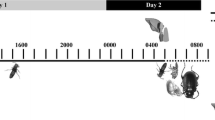Abstract
Dynastid scarab beetles are the main or exclusive pollinators ofAnnona spp. with large flowers and wide floral chambers. These nocturnal beetles are attracted by the characteristic odours which are caused by measurable temperature elevation of the flowers up to 10°C or even 15°C above the ambient air temperature. TheAnnona spp. investigated showed different floral rhythms varying from one to three days. The elaborate and wellcoordinated flowering processes, along with floral heating and olfactorial attraction of the night-activeCyclocephala spp., result in a very precise and effective pollination. The floral chamber provides alimentation for the beetles in the form of nutritious food-tissues and pollen and offers a mating place and a well developed shelter against predation and environmental changes. A staggered flowering period and an alternative attraction of different beetle species seems to be more a device for diminishing competition between the cooccurringAnnona spp. than a hybridization barrier.
Similar content being viewed by others
References
Beach, J. H., 1982: Beetle pollination ofCyclanthus bipartitus (Cyclanthaceae). — Amer. J. Bot69: 1074–1081.
—, 1984: The reproductive biology of the peach or “pejibaya” palm (Bactris gasipaes) and a wild congener (B. porschiana) in the atlantic lowlands of Costa Rica. — Principes28: 107–119.
Búrquez, A., Sarukhán, J., Pedroza, A. L., 1987: Floral biology of a primary forest palm,Astrocaryum mexicanum Liebm. — Bot. J. Linn. Soc.94: 407–419.
Fries, R. E., 1931: Revision der Arten einiger Annonaceen-Gattungen. — Acta Horti Bergiani10: 129–341, tt. 1–27.
—, 1959:Annonaceae. — InMelchior, H., (Ed.): Die natürlichen Pflanzenfamilien. 2nd edn.17 a II. — Berlin: Duncker & Humblot.
Gottsberger, G., 1970: Beiträge zur Biologie von Annonaceen-Blüten. — Österr. Bot. Z.118: 237–279.
—, 1985a: Pollination and dispersal in theAnnonaceae. —Annonaceae Newsletter1: 6–7. — Utrecht: Inst. Syst. Bot.
—, 1985b: Floral ecology. Report on the years 1981 (79) to 1985. — InBehnke, H.-D., Esser, K., Kubitzki, K., Runge, M., Ziegler, H., (Eds.): Progress in botany47, pp. 384–417. — Berlin, Heidelberg, New York, Tokyo: Springer.
—, 1986: Some pollination strategies in neotropical savannas and forests. — Pl. Syst. Evol.152: 29–45.
—, 1988: The reproductive biology of primitive angiosperms. — Taxon37: 630–643.
—,Amaral, Jr., A., 1984: Pollination strategies in BrazilianPhilodendron species. — Ber. Deutsch. Bot. Ges.97: 391–410.
—,Silberbauer-Gottsberger, I., 1988: Pollination strategies ofAnnona species from the cerrado vegetation in Brazil. — Lagascalia,15 (Extra): 665–672.
Martius, C. Fr. Ph. De, 1841:Annonaceae. — InMartius, C. Fr. Ph. De, (Ed.): Flora Brasil.13/1, pp. 1–64, tt. 1–14.
Morawetz, W., 1984: Karyologie, Ökologie und Evolution der GattungAnnona (Annonaceae) in Pernambuco, Brasilien. — Flora175: 435–447.
—, 1986: Systematics and karyoevolution inMagnoliidae: Tetrameranthus as compared with otherAnnonaceae genera of the same chromosome number. — Pl. Syst. Evol.154: 147–173.
Pellmyr, O., Thien, L. B., 1986: Insect reproduction and floral fragrances: keys to the evolution of the angiosperms? — Taxon35: 76–85.
Prance, G. T., Anderson, A. B., 1976: Studies of the floral biology of neotropicalNymphaeaceae. 3. — Acta Amazonica6: 163–170.
—,Arias, J. R. 1975: A study of the floral biology ofVictoria amazonica (Poepp.)Sowerby (Nymphaeaceae). — Acta Amazonica5: 109–139.
Safford, W. E., 1914: Classification of the genusAnnona with descriptions of new and imperfectly known species. — Contrib. U.S. Natl. Herb.18: 1–68, tt. 1–41.
Schatz, G. E., Young, H. J., 1985: Patterns of visitation by dynastine scarab pollinators in a Costa Rican tropical wet forest. — Abstracts Int. Congr. Syst. Evol. Biol. 3, Brighton, 1 page.
Valerio, C. E., 1984: Insect visitors to the inflorescence of the aroidDieffenbachia oerstedii (Araceae) in Costa Rica. — Brenesia22: 139–146.
Warming, E., 1892: Lagoa Santa. Et Bidrag til den biologiske Plantegeografi. — Kjøbenhavn: F. Dreyer.
Webber, A. C., 1981a: Biologia floral de algumasAnnonaceae na região de Manaus A. M. — Thesis I. N. P. A., Manaus.
—, 1981b: Alguns aspectos da biologia floral deAnnona sericea Dun. (Annonaceae). — Acta Amazonica11: 61–65.
Young, H. J., 1986: Beetle pollination ofDieffenbachia longispatha (Araceae). — Amer. J. Bot.73: 931–944.
Author information
Authors and Affiliations
Rights and permissions
About this article
Cite this article
Gottsberger, G. Beetle pollination and flowering rhythm ofAnnona spp. (Annonaceae) in Brazil. Pl Syst Evol 167, 165–187 (1989). https://doi.org/10.1007/BF00936404
Received:
Issue Date:
DOI: https://doi.org/10.1007/BF00936404




